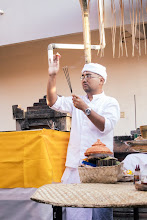The basic principle behind the rule of thirds is to imagine breaking an image down into thirds (both horizontally and vertically) so that you have 9 parts. As follows.

As you’re taking an image you would have done this in your mind through your viewfinder or in LCD display that you use to frame your shot. With this grid in mind the ‘rule of thirds’ now identifies four important parts of the image that you should consider placing points of interest in as you frame your image.
Not only this - but it also gives you four ‘lines’ that are also useful positions for elements in your photo.
The theory is that if you place points of interest in the intersections or along the lines that your photo becomes more balanced and will enable a viewer of the image to interact with it more naturally. Studies have shown that when viewing images that people’s eyes usually go to one of the intersection points most naturally rather than the center of the shot - using the rule of thirds works with this natural way of viewing an image rather than working against it.

Using the Rule of Thirds comes naturally to some photographers but for many of us takes a little time and practice for it to become second nature.
In learning how to use the rule of thirds (and then to break it) the most important questions to be asking of yourself are:
* What are the points of interest in this shot?
* Where am I intentionally placing them?
Once again - remember that breaking the rule can result in some striking shots - so once you’ve learnt it experiment with purposely breaking it to see what you discover.
Lastly - keep the rule of thirds in mind as you edit your photos later on. Post production editing tools today have good tools for cropping and reframing images so that they fit within the rules. Experiment with some of your old shots to see what impact it might have on your photos.
tips by
rick gondrong





 RSS Feed (xml)
RSS Feed (xml)




